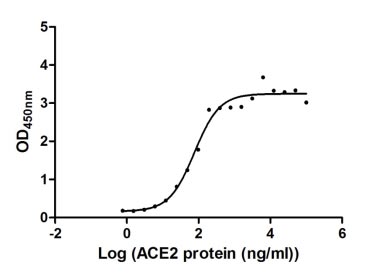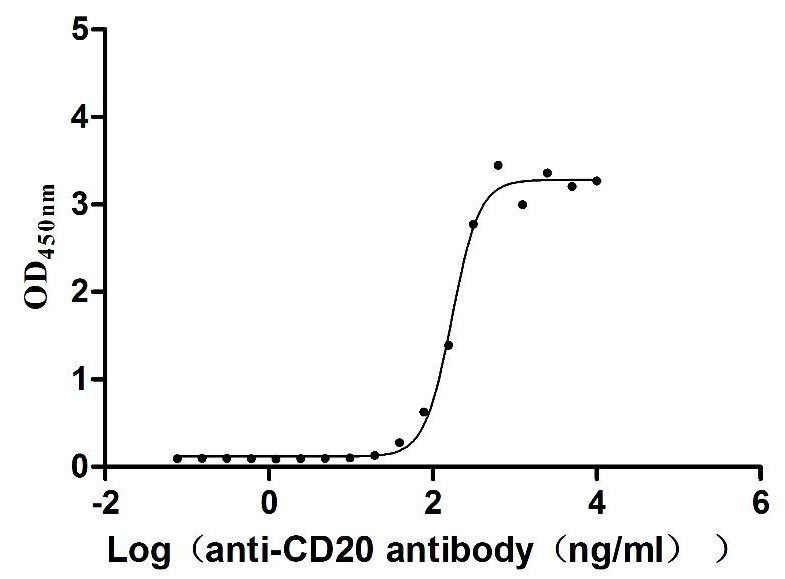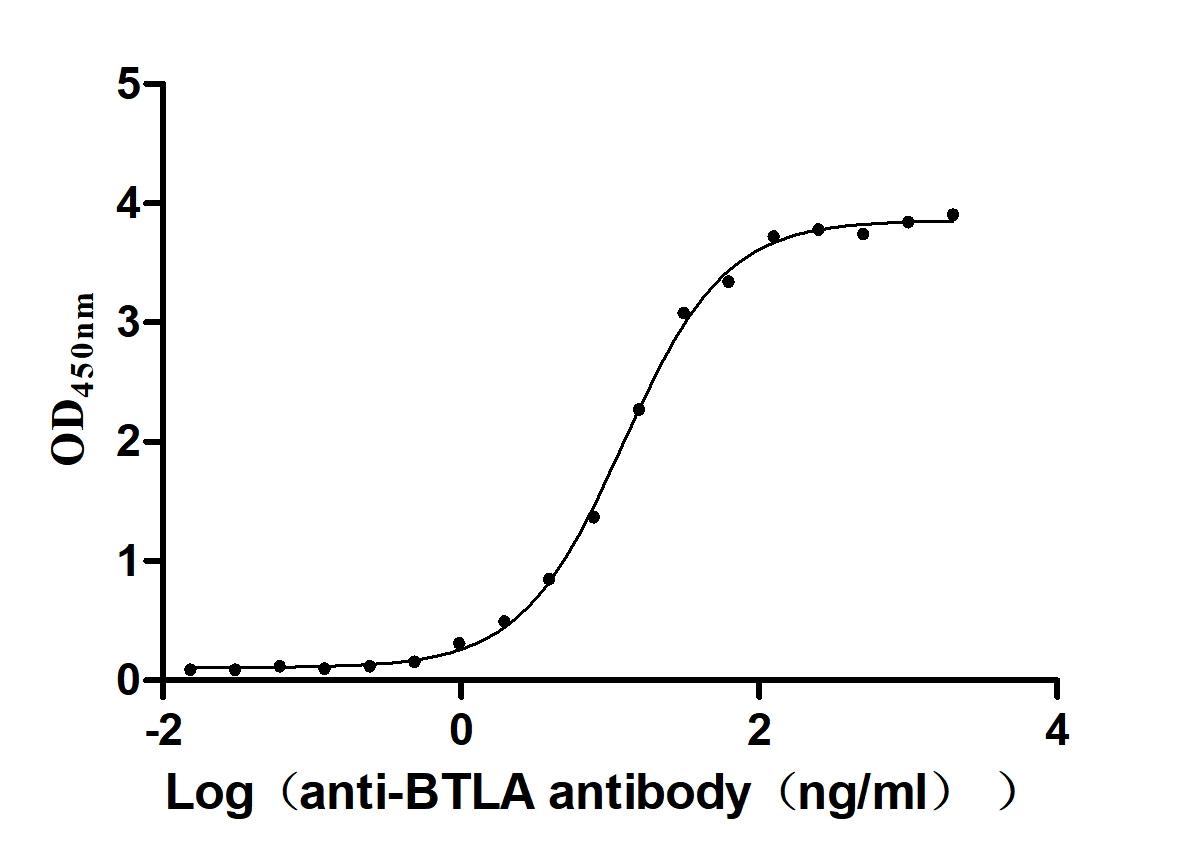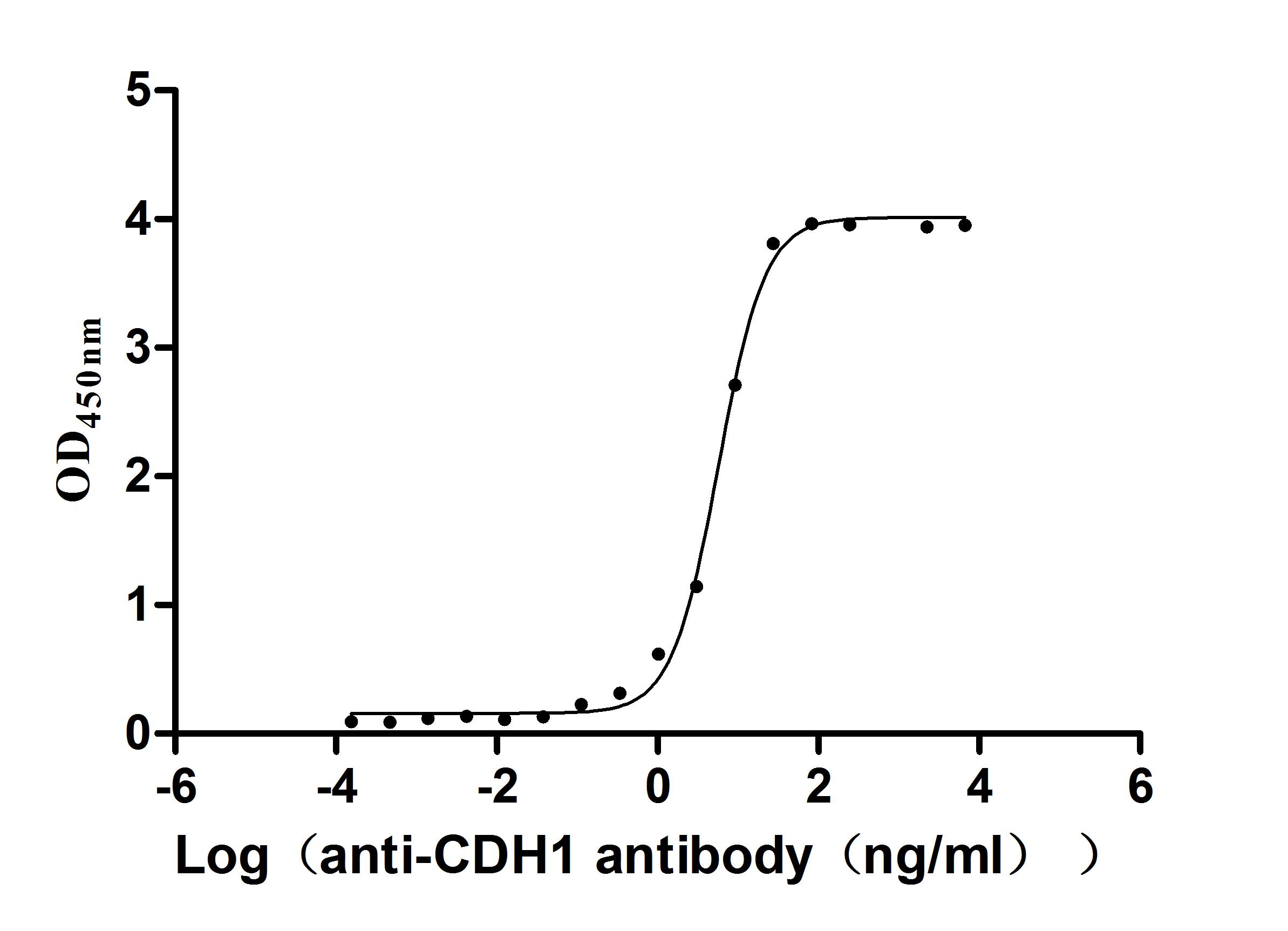Recombinant Mouse C-X-C motif chemokine 13 (Cxcl13)
-
货号:CSB-YP006243MO
-
规格:
-
来源:Yeast
-
其他:
-
货号:CSB-EP006243MO
-
规格:
-
来源:E.coli
-
其他:
-
货号:CSB-EP006243MO-B
-
规格:
-
来源:E.coli
-
共轭:Avi-tag Biotinylated
E. coli biotin ligase (BirA) is highly specific in covalently attaching biotin to the 15 amino acid AviTag peptide. This recombinant protein was biotinylated in vivo by AviTag-BirA technology, which method is BriA catalyzes amide linkage between the biotin and the specific lysine of the AviTag.
-
其他:
-
货号:CSB-BP006243MO
-
规格:
-
来源:Baculovirus
-
其他:
-
货号:CSB-MP006243MO
-
规格:
-
来源:Mammalian cell
-
其他:
产品详情
-
纯度:>85% (SDS-PAGE)
-
基因名:
-
Uniprot No.:
-
别名:Cxcl13; Blc; Scyb13C-X-C motif chemokine 13; B lymphocyte chemoattractant; CXC chemokine BLC; Small-inducible cytokine B13
-
种属:Mus musculus (Mouse)
-
蛋白长度:Full Length of Mature Protein
-
表达区域:22-109
-
氨基酸序列ILEAHYTNL KCRCSGVIST VVGLNIIDRI QVTPPGNGCP KTEVVIWTKM KKVICVNPRA KWLQRLLRHV QSKSLSSTPQ APVSKRRAA
-
蛋白标签:Tag type will be determined during the manufacturing process.
The tag type will be determined during production process. If you have specified tag type, please tell us and we will develop the specified tag preferentially. -
产品提供形式:Lyophilized powder
Note: We will preferentially ship the format that we have in stock, however, if you have any special requirement for the format, please remark your requirement when placing the order, we will prepare according to your demand. -
复溶:We recommend that this vial be briefly centrifuged prior to opening to bring the contents to the bottom. Please reconstitute protein in deionized sterile water to a concentration of 0.1-1.0 mg/mL.We recommend to add 5-50% of glycerol (final concentration) and aliquot for long-term storage at -20℃/-80℃. Our default final concentration of glycerol is 50%. Customers could use it as reference.
-
储存条件:Store at -20°C/-80°C upon receipt, aliquoting is necessary for mutiple use. Avoid repeated freeze-thaw cycles.
-
保质期:The shelf life is related to many factors, storage state, buffer ingredients, storage temperature and the stability of the protein itself.
Generally, the shelf life of liquid form is 6 months at -20°C/-80°C. The shelf life of lyophilized form is 12 months at -20°C/-80°C. -
货期:Delivery time may differ from different purchasing way or location, please kindly consult your local distributors for specific delivery time.Note: All of our proteins are default shipped with normal blue ice packs, if you request to ship with dry ice, please communicate with us in advance and extra fees will be charged.
-
注意事项:Repeated freezing and thawing is not recommended. Store working aliquots at 4°C for up to one week.
-
Datasheet :Please contact us to get it.
相关产品
靶点详情
-
功能:Strongly chemotactic for B-lymphocytes, weakly for spleen monocytes and macrophages but no chemotactic activity for granulocytes. Binds to BLR1/CXCR5. May play a role in directing the migration of B-lymphocytes to follicles in secondary lymphoid organs.
-
基因功能参考文献:
- CXCL13, upregulated by peripheral inflammation, acts on CXCR5 on dorsal root ganglia neurons and activates p38, which increases Nav1.8 current density and further contributes to the maintenance of inflammatory pain. PMID: 27708397
- This study indicated that CXCL13 may be pathogenically involved in Clostridium difficile infection (CDI) and served as a potential new biomarker for diagnosis and prognosis in CDI. PMID: 27685937
- CXCL13 has a role in directing B-lymphocyte migration PMID: 27477203
- CXCL13 and CXCR5 contribute to orofacial pain via ERK-mediated proinflammatory cytokines production. PMID: 27401148
- High glucose could inhibit osteogenic differentiation of mesenchymal stem cells by lncRNA AK028326 mediated down-regulation of CXCL13 expression. PMID: 27693963
- Data demonstrate that CXCL13 is not essential in mounting effective peripheral humoral responses, but specifically promotes CNS accumulation of differentiated B cells. PMID: 26795429
- overexpression of CXCL13 is associated with myasthenia gravis. PMID: 26771137
- Deficiency in Cxcl13 or its receptor, Cxcr5, significantly attenuated benzo(a)pyrene-induced lung cancer in mice, demonstrating CXCL13's critical role in polycyclic aromatic hydrocarbon-induced lung carcinogenesis. PMID: 26565418
- Blockade of CXCL13 significantly reduced urine protein, serum creatinine, and dramatically attenuated renal pathology injury in lupus nephritis in mice. PMID: 26456520
- Results from this study suggest blockade of CXCL13 and BAFFR together may be an effective therapeutic strategy in preventing salivary hypofunction and reducing autoantibody titers and sialadenitis in patients with Sjogren's syndrome PMID: 26826598
- findings reveal a neuronal/astrocytic interaction in the spinal cord by which neuronally produced CXCL13 activates astrocytes via CXCR5 to facilitate neuropathic pain. PMID: 26752644
- Study reports a novel role of AK141205/CXCL13 as a regulator of osteogenic growth peptide-induced osteogenic differentiation of smooth muscle cells. PMID: 26321662
- Data indicate that CXC chemokine CXCL13-responsive late transitional B cells are the initiating subset for the positive feedback loop. PMID: 25662995
- Study demonstrates that microglia are an important source of CXCL13 production in the acutely inflamed brain, and in vitro experiments confirm that type-I IFN selectively inhibits microglial production of CXCL13 in a dose-dependent manner PMID: 24829092
- Data suggest that Src homology 3 (SH3) protein interacting with NcK, 90 kDa (SPIN90)plays an important role in B cell immune responses through the regulation of chemokine CXCL13-mediated B cell migration. PMID: 24965518
- mediates vaccine-induced immunity against tuberculosis PMID: 23299616
- CXCL13 may be pathogenically involved in SS and may serve as a new marker and a potential therapeutic target. PMID: 23904442
- CXCL13 is produced within lymphoid follicles of patients with COPD and is crucial for the formation of TLOs. PMID: 23742729
- Late stage cathepsin C, CXCL13 and Ki-67 overexpression correlate with regional neuropathology in a bovine spongiform encephalopathy transgenic murine model. PMID: 22789860
- Interruption of CXCL13-CXCR5 axis increases upper genital tract pathology and activation of NKT cells following chlamydial genital infection. PMID: 23189125
- Data show that CXCL13/CXCR5 facilitated antigen encounter and BCR signaling by promoting membrane ruffling and LFA-1-supported adhesion require a functional actin cytoskeleton and the activity of the motor protein non-muscle myosin II (NM-II). PMID: 21659539
- LTBR-pathway in Sjogren's syndrome: CXCL13 levels and B-cell-enriched ectopic lymphoid aggregates in NOD mouse lacrimal glands are dependent on LTBR. PMID: 21153342
- found enhanced plasma levels of CXCL13 in lupus-prone MRL/lpr and NZB/W-F1 mice PMID: 21084753
- Dendritic cells produce CXCL13 and participate in the development of murine small intestine lymphoid tissues PMID: 20304952
- Disease-associated B lymphocyte selection into islets occurs despite CXCL13 blockade- induced disruption of their structural organization; loss of B cell organization in islets do not provide disease protection. PMID: 20574003
- elevated expression and different distribution in the aged spleen PMID: 19845796
- New putative control elements in the promoter OF CXCL13 chemokine gene, a target of alternative NF-kappaB pathway PMID: 19807029
- CXCL13 is essential for the spatial arrangement of lymphocytes within granulomas, optimal activation of phagocytes, and subsequent control of mycobacterial growth. PMID: 19933855
- A subset of dendritic cells expressing CXCR5 migrate rapidly into the primary lymphoid follicles from the marginal zone in response to CXC ligand 13 (B lymphocyte chemoattractant, CXCL13) via a B cell-derived, membrane lymphotoxin-dependent mechanism. PMID: 11994465
- CXCR5/CXCL13 signaling activates alpha4beta1 integrin on CD4+CD3- cells. PMID: 12354388
- its aberrant high expression is a cause of SLE--review PMID: 12518463
- CXCL13 expressed in the high endothelial venule lumen plays a crucial role in B cell trafficking into secondary lymphoid tissues such as Peyer's patches. PMID: 12902460
- The tissue architecture of the lymphoid clusters induced in the chronic lesion of autoimmune gastritis is supported by a typical lymphoid reticular network and follicular dendritic cells expressing the B cell homing chemokine, CXC chemokine ligand 13. PMID: 14530361
- This experiment find that gene expression of CXCL13, a chemokine involved in B-cell recruitment into lymphoid follicles.the presence of lymphoid follicle-like structures containing B cells. PMID: 14975582
- data identify CXCL13 as an arrest chemokine for B cells in high endothelial venules and that CXCL13 plays an important role in B-cell entry into not only Peyer patches but also mesenteric lymph nodes PMID: 15972452
- B-cell defects in the nasal-associated lymphoid tissue of lymphotoxin(-/-) mice can be attributed to the impaired expression of CXCL13. PMID: 16210592
- double-negative (DN) Treg cells preferentially express Burkitt lymphoma receptor 1, and interaction of this chemokine receptor with its ligand CXCL13 plays an important role in DN Treg cell migration both in vitro and in vivo PMID: 16621993
- CXCL13 plays a pathogenic role in experimental autoimmune encephalomyelitis, particularly during the effector phase. PMID: 16751415
- ability of CXCL13 and sphingosine1-phosphate to direct the trafficking and localization of B cells in vivo may be dependent on Rap activation PMID: 16821235
- Pulmonary expression of Cxcl13 is essential for local immunity to influenza. PMID: 17563386
- study shows CCL21 & CXCL13 are transiently down-regulated in lymphoid tissues during immune responses by a mechanism controlled by interferon-gamma; the modulation altered localization of lymphocytes & dendritic cells within responding lymphoid tissues PMID: 17673664
- Survival after UVA irradiation was greater in human keratinocytes compared to mouse skin with no S100A2 expression, showing a protective role for S100A2. A S100A2-dependent difference was observed in the induction of Cxcl13 transcripts in transgenic mice. PMID: 18773213
- The activation of both canonical and non-canonical nuclear factor-kappaB (NF-kappaB) pathways was essential for CXCL13 induction. PMID: 19251935
- Unlike conventional lymphoid organs, milky spots in the omentum developed in the absence of lymphoid tissue-inducer cells, but required the chemokine CXCL13 PMID: 19427241
- RA induces CXCL13 expression and is essential for lymph node formation. PMID: 19783990
显示更多
收起更多
-
亚细胞定位:Secreted.
-
蛋白家族:Intercrine alpha (chemokine CxC) family
-
组织特异性:Found in spleen (B-cell-rich zone or follicles), Peyer patches (strongest within germinal centers and extending to the mantle zone) and lymph nodes (in reticular pattern in follicles).
-
数据库链接:
KEGG: mmu:55985
STRING: 10090.ENSMUSP00000023840
UniGene: Mm.10116
Most popular with customers
-
Recombinant Human Angiotensin-converting enzyme 2 (ACE2), partial (Active)
Express system: Mammalian cell
Species: Homo sapiens (Human)
-
Recombinant Dog B-lymphocyte antigen CD20 (MS4A1)-VLPs (Active)
Express system: Mammalian cell
Species: Canis lupus familiaris (Dog) (Canis familiaris)
-
Recombinant Human Cadherin-17 (CDH17), partial (Active)
Express system: Mammalian cell
Species: Homo sapiens (Human)
-
Recombinant Human Myosin regulatory light chain 12A (MYL12A) (Active)
Express system: E.coli
Species: Homo sapiens (Human)
-
Recombinant Human B- and T-lymphocyte attenuator(BTLA), partial (Active)
Express system: Mammalian cell
Species: Homo sapiens (Human)
-
Recombinant Human C-C chemokine receptor type 6(CCR6)-VLPs (Active)
Express system: Mammalian cell
Species: Homo sapiens (Human)
-
Recombinant Human Cadherin-1(CDH1),partial (Active)
Express system: Mammalian cell
Species: Homo sapiens (Human)



















